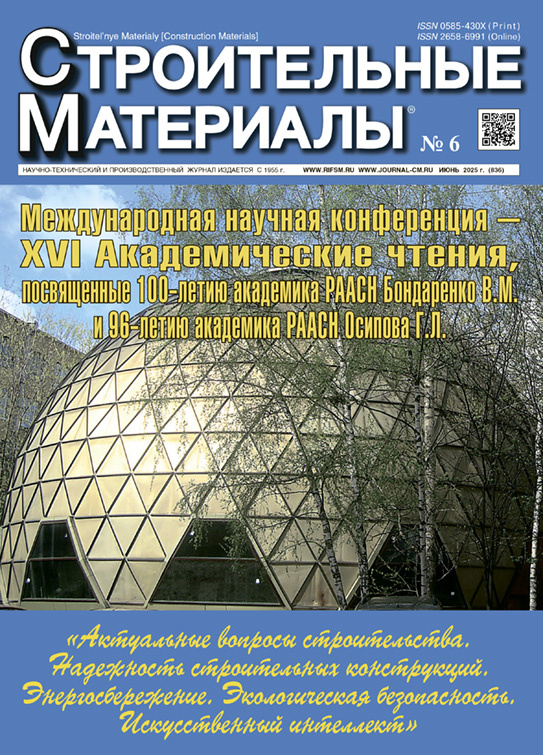Dynamic characteristics of the elastic layer materials of floating floor structures actualization
- Authors: Rogalev A.M.1
-
Affiliations:
- Scientific-Research Institute of Building Physics of RAACS
- Issue: No 6 (2025)
- Pages: 29-33
- Section: Статьи
- URL: https://rjonco.com/0585-430X/article/view/688333
- DOI: https://doi.org/10.31659/0585-430X-2025-836-6-29-33
- ID: 688333
Cite item
Abstract
The results of the modern soundproofing materials used in floating floor structures dynamic characteristics experimental studies are presented. The work relevance is due to the need to update the soundproofing materials dynamic characteristics tabular values presented in SP 275.1325800.2016 “Enclosing structures of residential and public buildings. Sound insulation design rules”. The study examined the most common materials on the market: rock wool, polyethylene foam, needle-punched fiberglass mats and roll soundproofing materials. It is established that the maximum values of the elasticity dynamic modulus are demonstrated by rock wool materials, the minimum values are foamed polyethylene and fiberglass mats. The elasticity dynamic modulus dependences on thickness, density and load for different materials are revealed. For 30 mm thick rock wool under 10000 Pa load, the increase in density from 100 to 155 kg/m3 leads to an increase in modulus from 1.88 to 2.22 MPa. For needle-punched fiberglass mats with a load of 5000 Pa, an increase in thickness from 10 to 14 mm causes an increase in the modulus by 0.27 MPa. The study results allow to expand the possibilities of choosing soundproofing materials in the design and increase the impact noise reduced level index calculation accuracy.
Full Text
About the authors
A. M. Rogalev
Scientific-Research Institute of Building Physics of RAACS
Author for correspondence.
Email: amrogalev@yandex.ru
Lead Engineer
Russian Federation, 21, Lokomotivniy Driveway, Moscow, 127238References
- Porozhenko M.A. Impact noise insulation by building enclosing structures. BST: Byulleten’ Stroitel’noy Tekhniki. 2018. No. 6 (1006), pp. 34–35. (In Russian). EDN: UQJRIE
- Kryshov S.I., Kotelnikov D.E., Gradova O.V. Problems of sound insulation of inter-floor floors in panel buildings and the application of the law of mass. Stroitel’nye Materialy [Construction Materials]. 2021. No. 6, pp. 30–32. (In Russian). EDN: SMIITX. https://doi.org/10.31659/0585-430X-2021-792-6-30-32
- Shubin I.L., Aistov V.A., Porozchenko M.A. Sound Insulation of enclosing Structures in high-rise Buildings. Requirements and methods of support. Stroitel’nye Materialy [Construction Materials]. 2019. No. 3, pp. 33–43. (In Russian). EDN: ZIKFGH. https://doi.org/10.31659/0585-430X-2019-768-3-33-43
- Gradova O.V., Rogalev A.M. Improvement of shock noise insulation by elastic gaskets in floating floor structures. Stroitel’nye Materialy [Construction Materials]. 2024. No. 6, pp. 26–29. (In Russian). EDN: AHNSYJ. https://doi.org/10.31659/0585-430X-2024-825-6-26-29
- Kryshov S.I., Kotelnikov D.E., Gradova O.V. Dependence of impact noise insulation on the composition of structural layers of floor coverings. BST: Byulleten’ Stroitel’noy Tekhniki. 2021. No. 6 (1042), pp. 16–17. (In Russian). EDN: QPFACX
- Rogalev A.M. Rational choice of soundproofing material from stone wool in floating floor structures. Privolzhskiy Nauchnyy Zhurnal. 2024. No. 4 (72), pp. 18–26. (In Russian). EDN: QZZIIZ
- Gerasimov A.I., Vasiliev M.D., Svetlorussova A.M. Losses of acoustic energy during the passage of a sound wave through a porous-fibrous material. Noise Theory and Practice. 2019. Vol. 5. No. 4 (18), pp. 46–52. (In Russian). EDN: NMMXJE
- Taranov D.K., Fedyuk R.S. On the dependence of sound insulation and dynamic rigidity of the “floating floor” technology. Development of the concept of modern education in the framework of scientific and technological progress: Collection of scientific papers. Kazan. 2020, pp. 157–160. (In Russian). EDN: VRQDNE
- Gerasimov A.I., Nikonova E.V. Influence of structural parameters of the material on its soundproofing qualities. Nauka i biznes: puti razvitiya. 2018. No. 6 (84), pp. 60–63. (In Russian). EDN: XWTOXR
Supplementary files













